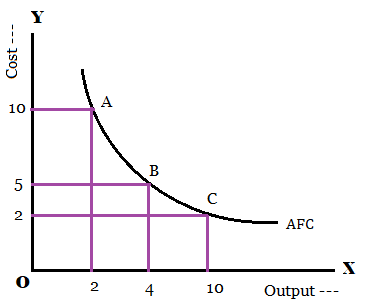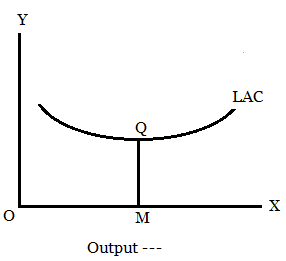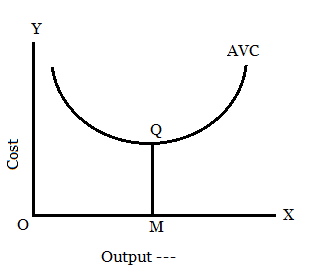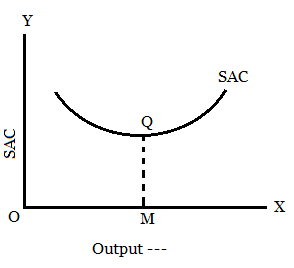Hi friends, in today’s article we are going to know about the nature of Short run and Long run average cost curves and why is the long run average cost curve is flatter than the short run average cost curve?. So let’s discuss in details.
Table of Contents
Short run and Long run Average cost curves
Average cost (AC) is nothing but the per unit cost of output. It is found by dividing total cost by the level of output. Symbolically,
AC = TC/Q
Where,
AC = Average Cost,
TC = Total Cost and
Q = Output.
Period wise it can be classified into two broad group that is –
(i) Short run average cost (SAC) and
(ii) Long run average cost (LAC).
(i) Short run average cost
Short run average cost is the sum of average fixed cost (AFC) and average variable cost (AVC). So it has been fixed and variable components. Equationally it can be determined –
SAC = TC/Q + TFC/Q + TVC/Q
⇒ AC = AFC + AVC
Average Fixed Curve (AFC)
The average fixed curve (AFC) is a rectangular hyperbola. Suppose TFC is Rs.20 when output is 2, which is shown by point A in the figure.

The AFC is the same at all levels of output. If output is zero, AFC is not zero and it is infinite. Symbolically,
AFC = TFC/Q = ∝
That is why the AFC curve never touches the vertical axis. AFC can never be zero since TFC is always positive. So AFC curve can not touch horizontal axis. Thus the AFC curve is a rectangular hyperbola.
Average Variable Cost Curve (AVC)
When total variable cost (TVC) is divided by total quantity then it is called average variable cost (AVC). Average variable cost is calculated by using the following formula –
AVC = TVC/Q
AVC is ‘U’ shaped. The slope of the AVC curve depends on the law of variable proportions. In the first stage of production process, when a firm enjoys increasing returns to the variable factor.
In the second phase the firm faces diminishing return and the last stage cost is increases.
The Shape of the SAC curve
Like the AVC curve the shape of the SAC curve is also ‘U’ shaped. It is happened due to the operation of the law of variable proportions. The shape of the SAC curve depends on two sets of forces-pull and push forces.
In along side figure outputs are measured OX axis and SAC on the OY axis. SAC curve is initially falls due to the law of increasing returns and after reaching its minimum point starts law of diminishing returns. Finally SAC curve starts raising due to the law of negative returns.
(ii) Long run average cost
Long run is a sufficient time period for the firms to change the all factors of production. So, in the long run all factors of production are variable.
Long run average cost is obtained by dividing the long run total cost by the quantity of output. It is also known as per unit cost of production. Symbolically,
LAC = LTC/Q
We can derive the LAC from the SAC. In figure, LAC is the long run average cost curve. It is the same size as like as the SAC curve. Long run average cost first declines, reaches a minimum point (Q) then increases.

In between it is content when economics of scale are counter balanced by the diseconomies of scale. Like SAC curve, LAC curve also ‘U’ shaped but it is relatively flatter.
FAQs
What is long run average cost curve?
Long run average cost is obtained by dividing the long run total cost by the quantity of output. It is also known as per unit cost of production. Symbolically, LAC = LTC/Q
What is average variable cost curve?
When total variable cost (TVC) is divided by total quantity then it is called average variable cost (AVC). Average variable cost is calculated by using the following formula - AVC = TVC/Q
What is Average Fixed Curve?
The average fixed curve (AFC) is a rectangular hyperbola.
What is Short run average cost?
Short run average cost is the sum of average fixed cost (AFC) and average variable cost (AVC). So it has been fixed and variable components.
Conclusion
So friends, this was the concept of Short run and Long run average cost curves. Hope you get the full details about it and hope you like this article.
If you like this article, share it with your friends and turn on the website Bell icon, so don’t miss any articles in the near future. Because we are bringing you such helpful articles every day. If you have any doubt about this article, you can comment us. Thank You!
Read More Article
• Marginal Efficiency of Capital | Factors affecting Marginal Efficiency of Capital
• Explain the Relationship between Average revenue and Marginal revenue



